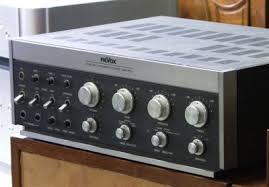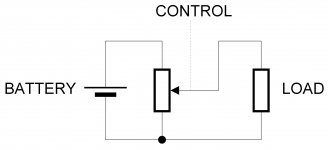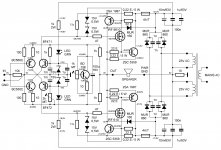Thank-you for pointing that (i was begining to ask myself about my mind sanity).Similarities with classical current feedback topology exist of course, I would be foolish not to admit that, but some guys here would like to sell me that SSA is the same.
It is just like paintings, they use the same kind of supports and similar color tubes ;-)
Or like music, all tunes use the same 12 notes...
Nothing is new in Electronic, but organizing old ideas in an harmonious new way brings a *new* design.
I wonder how people can look at a same schematic is such different ways, different analysis, different feelings.
One thing was interesting for me, in that historical search: I am dedicated to current feedback since listening to the Mark Alexander amp.
And i used to replace all the AOPs of my desks with AD Current Feedback ICs.
Looking at this Revox schematic, i realize that, around 10 years before, i had chosen blind, for his sonic quality, between may-be 10 different and famous high end professional amps, a Studer A68. And i realize it was the only one between all of them using current feed-back too.
By the way, L.C., because i suppose you have tested many output and input devices, can-you tell us your feelings about sonic differences, according to the technology of the output devices, Bipolars, Hex fets, vertical or lateral power MOS, BIGBTs?
Also in the tech of the input device, Fet or Bipolar ?
Also in the tech of the input device, Fet or Bipolar ?
Hi guys
Similarities with classical current feedback topology exist of course, I would be foolish not to admit that, but some guys here would like to sell me that SSA is the same. Mistake. I have to disappoint them in a major way. It is not. In the past I tested those classical current feedback schematics they posted above as a proof of copying. It was always disappointment listening to those creatures, I never liked them at all, never satisfied with the sound coming out of a speaker.
So I put the SSA in action.
SSA is unique idea because there's no existing amplifier's schematic the same, similar like the ones posted, but not the same. SSA is evolution from that point on. The major advantage of SSA principle is in merging, using a single gain device for feedback, modulation, differentiation and bias in a balanced bridge configuration. Everything is locked inside, it also has locked - unmatched sound signature (proved already by forum members, many ask themselves how come) because everything is happening in a circle of a single gain device for all the tasks needed to create an amplifier, simple and profound. Everything after this stage is just impedance matching till the output pins. Still important, like BIGBT output stage, but not crucial to get a perfect SSA sound.
Sorry to burst your bubble but it is. This circuit is attributed to JLH which was the first to make use of it, the idea of adding a cascode to it was developed by hawksford and used in a preamp which was commercially available. We all know that it doesnt take much to modify any preamp circuit to become a poweramp. BTW I doubt hawksford and his partner will be very happy that you are are using his circuit ideas and not giving any credit to him.
As already shown by another member the circuit actually performs better without the cascode which brings me to another user of this circuit, Bruce DePalma, one of the most prolific audio designers of all time and has more than 50 years experience in audio design (tube and solidstate) and was chief engineer at Dynaco. He better than most understands how this circuit operates and you could get some pointers from him to help with the tempco problems people experience, he has had those covered for many many years.
Sorry to burst your bubble but it is. This circuit is attributed to JLH which was the first to make use of it, the idea of adding a cascode to it was developed by hawksford and used in a preamp which was commercially available. We all know that it doesnt take much to modify any preamp circuit to become a poweramp. BTW I doubt hawksford and his partner will be very happy that you are are using his circuit ideas and not giving any credit to him.
As already shown by another member the circuit actually performs better without the cascode which brings me to another user of this circuit, Bruce DePalma, one of the most prolific audio designers of all time and has more than 50 years experience in audio design (tube and solidstate) and was chief engineer at Dynaco. He better than most understands how this circuit operates and you could get some pointers from him to help with the tempco problems people experience, he has had those covered for many many years.
I don't see any j-fet in my circuit ...
BTW I doubt hawksford and his partner will be very happy that you are are using his circuit ideas and not giving any credit to him.
I don't see anywhere in the forum anybody giving a credit to a guy who invented principle of controling current flow, basics of all linear amplifying circuits.
P.S. Triode tube came long after that ...

Attachments
Last edited:
Please can-you moderate your asserts ?I doubt hawksford and his partner will be very happy that you are are using his circuit ideas and not giving any credit to him .
Laws are very precise about copyrights and patents and, i do not see any violation of them in the*original* L.C.design .
As i said previously, all circuit's single combinations you can make or imagine had yet been done by somebody, somewhere, as long as electronic is the matter.
And those combinations, named or not, are the ones we all learn at school.
And, as long as some is enough experienced in electronic, there is no "better than most understanders".
Just ingeneers with more or less taste, luck or imagination, Like Chiefs in cooking. And better feelings of the currents, bandwidths , poles, parasitics selfs and capacitors etc...
When you are working in a professional R&d office, as an example, you have no time to read or know everything that has been done elsewhere, and no interest to copy because it is too much time consuming.
You begin from scratch, because the situation in witch you are is unique. Components providers, availability and prices you can get for the parts, marketing targets...
Most of the commercial amps schematics look more or less the same, no one IS the same. No one sound the same.
Even if you are not able to taste-it, SSA has an unique flavor...
And i bet that L.C. do not knew the work or even the name of many people you are referencing to.
But, may-be i'm wrong ?
I am sure of one thing, L.C. work for his pleasure and you got no fun at all in copying.
Last edited:
Well , for the double path , why not a late 70s Revox B750..??...

Close but still only half way there.
And, about his sound, if i refer to the one i'm listening to in this instant ;-), close, but only quarter the way there.Close but still only half way there.
What a bunch of crab.....inspiration is there for the taking....I do think that the SSA i a refreshing new approach, some may have walked along the paths previously...but then look at pop-songs.. same chords but still unique in their own way...I have my own take on the SSA..my own interpretation.. well not really my own, but part of it my own, making it totally different from all that has been published here...Yet with heavy rework and new considerations putting my own flavor to a the already fine recipe published here, Think no matter what you aim to design we owe a lot to the Old-timers like Hawksford, Lindsley Hood, Curl, Pass just to mention a few...when digesting a circuit all elements have been seen and described before...Now this is NOT a University master so there's no need for for an accurate source on all your statements and decisions...No need for keeping records straight, This is just one fantastic guy sharing his amazing work and thoughts...We'ed better praise him for that rather that chasing him for somethings he may of may not be aware of...LC...Bring it ON..!!
I'm assembling an amp with Thermaltrak output devices. I played a little with Roender's output buffer, but decided that the thermal compensation was going to be tricky, with too many interacting elements (to many for my skill level, anyway). So I'm going to work with Andrej's Thermaltrak design.
Question: Any benefit from paralleling a few BC550/60 devices for the driver, as opposed to a single lower gain device?
Sheldon
Question: Any benefit from paralleling a few BC550/60 devices for the driver, as opposed to a single lower gain device?
Sheldon
Please, L.C. don't loose your precious time with that, it is just noise.Vice versa.
And please, mister homemodder, better open your own thread to show-us your own work, and share your original and innovating ideas instead of publish aggressive comments about a generous and talented designer witch share his work, help everybody here in an incredibly generous matter and has brought-us one of the best sounding amp idea i had listened too.
Love-it, or leave-it.
Last edited:
Very impressive, indeed.Ive tasted the SSA flavour 20 years ago as a first year student
On my side i was engineer in the R&D department of the most important French hifi company at this time (Scientelec) co author of several amps (mach 50), then head of the electro acoustic department during the 70th, before to begin my sound engineer career, and then ?
Last edited:
the most important French hifi company at this time (Scientelec)
Remember it , very original designs...

Oh, man, a nightmare... The chassis had been f*****-up by the provider, no one wanted to take this in charge in the place. As i was young, they had ordered me to go in the "manufacturing unit" ? to solve the problems..Remember it , very original designs...
OOT:Their schematics (Elysee) were drawn from RCA application notes.
The making was horrible.
You are absolutely right (that was two years before my arrival in this company).
I will add that this cheap DIY electronic had made the fortune of the company, while the valuable, qualitative and original products witch had followed (some Mach 50 are still working todays more here) had driven this firm to his death. With a little help from his owner and manager, witch had finished in jail (for the little history).
But, let us return to SSA.
Last edited:
By the way, L.C., because i suppose you have tested many output and input devices, can-you tell us your feelings about sonic differences, according to the technology of the output devices, Bipolars, Hex fets, vertical or lateral power MOS, BIGBTs?
Also in the tech of the input device, Fet or Bipolar ?
I'm looking forward to LC's answer to this question. Also answer from anybody else. Imo, there are those who really are experts in this field, and there are those who really can hear. They are not always the same person.
Interesting to me is about the sound of IGBT or BIGBT output, which is LC's preference for this SSA amplifier. I have built/listened to several IGBT amps and imo they share the same "characteristics". Many of IGBT amps I have built were designed by Borivoje Jagodic or Boraomega (because I have a faith in his "capability"). I have also heard the Alexander amp that has been considered as the best amp in the world by many fellow DIYers (tho the topology is not common). My friend who built the Alexander amp with exotic parts and double sided PCB thought that it was the best amp, but he didn't even keep it for more than a few months (of course I don't know the real reason, but if it is the best amp anyone should have kept it imo).
IGBT amps indeed sound unique and impressive. I can understand if many "falls in love" with this kind of amplifier sound. I believe that many will be agree that the Alexander amp is the best sounding amp, but I also believe that many will be strongly disagree.
I myself like the "taste" of the IGBT, but I always think it is not so enjoyable for long time listening. Some listeners prefer sound by first impression, so they prefer impressive sound. Some others, usually experienced ones, have to listen for a very long time to decide, because they don't judge by first impression but by the enjoyment they experience from listening to the sound (it is related to fatigue and musicality).
I believe that if later anyone compare two SSA amps (where one is the BIGBT), the BIGBT will be worse in soundstage (I think soundstage is easier for everyone to perceive than fatigue).
As for input stage, I prefer bipolar to the standard JFET (K170). Standard JFET do not have "live" to my ears (=boring). I guess it is because of the low current capability of the JFET, because when paralleled (for high current capability) they show better sound. But I have never seen such in standard LTP arrangement.
As for input stage, I prefer bipolar to the standard JFET (K170). Standard JFET do not have "live" to my ears (=boring). I guess it is because of the low current capability of the JFET, because when paralleled (for high current capability) they show better sound. But I have never seen such in standard LTP arrangement.
Hi,
I post just to second your opinion on the J-FETs
About the (B)IGBT I hope we'll see more people sharing their impressions. I couldn't make mine temperature stable, but I must say after few months of listening to my SSA version with Lateral MOS-FETs, that I like it more than any other amp that I've owned or have had in my system so far. I'm one of those who have "to listen for a very long time to decide, because they don't judge by first impression but by the enjoyment they experience from listening to the sound"
IMO, the greatness of this circuit is in the topology itself and not in the type of the transistors. However, I don't believe that Pass F5, for example, being with J-FET input and very similar to SSA would sound the same.
Andrej, I don't care how original is your circuit! I personally think it's brilliant. The important fact for me is that it was very impressive and intriguing enough, so I decided to try it. And I'm very happy that I did! I love its simplicity and hidden complexity ...
- Status
- This old topic is closed. If you want to reopen this topic, contact a moderator using the "Report Post" button.
- Home
- Amplifiers
- Solid State
- Simple Symetrical Amplifier





